編輯:關於Android編程
0、基礎回顧
PropertyAnimation,屬性動畫,顧名思義就是利用對象的屬性變化形成動畫的效果。屬性動畫的類可以用Animator這個抽象類來表示,通常使用它的子類:AnimatorSet和ValueAnimator,同時ValueAnimator有兩個子類分別是ObjectAniamtor和TimeAnimator。
定義屬性動畫的XML資源的時候通常可以是如下三個元素之一作為根元素:
<set>元素:該資源元素代表的是AniamtorSet類,這個類可以包含<set>,<objectAniamtor>,<animator>三個子元素。
<objectAnimator>元素:用於定義objectAniamtor類。
<animator>元素:用於定義ValueAnimator類。
比如說這裡一個資源文件的定義如下:
<set android:ordering="[together|sequentially]">
<objectAnimator
android:propertyName="string"
android:duration="int"
android:valueFrom="float|int|color"
android:valueTo="float|int|color"
android:startOffset="int"
android:repeatCount="int"
android:interpolator=""
android:repeatMode="[reapeat|reverse]"
android:valueType="[intType|floatType]"/>
<animator
android:duration="int"
android:valueFrom="float|int|color"
android:valueTo="float|int|color"
android:startOffset="int"
android:repeatCount="int"
android:interpolator=""
android:repeatMode="[reapeat|reverse]"
android:valueType="[intType|floatType]"/>
<set>
....
</set>
</set>
屬性文件通常保存在animator文件夾下面。
1、如何使用xml文件來創建屬性動畫
大家肯定都清楚,View Animator 、Drawable Animator都可以在anim文件夾下創建動畫,然後在程序中使用,甚至在Theme中設置為屬性值。當然了,屬性動畫其實也可以在文件中聲明:
首先在res下建立animator文件夾,然後建立res/animator/scalex.xml
<?xml version="1.0" encoding="utf-8"?> <objectAnimator xmlns:android="http://schemas.android.com/apk/res/android" android:duration="1000" android:propertyName="scaleX" android:valueFrom="1.0" android:valueTo="2.0" android:valueType="floatType" > </objectAnimator>
代碼:
public void scaleX(View view)
{
// 加載動畫
Animator anim = AnimatorInflater.loadAnimator(this, R.animator.scalex);
anim.setTarget(mMv);
anim.start();
}
使用AnimatorInflater加載動畫的資源文件,然後設置目標,就ok~~是不是很簡單,這只是單純橫向的放大一倍~
如果我希望縱向與橫向同時縮放呢?則可以怎麼定義屬性文件:
<?xml version="1.0" encoding="utf-8"?>
<set xmlns:android="http://schemas.android.com/apk/res/android"
android:ordering="together" >
<objectAnimator
android:duration="1000"
android:propertyName="scaleX"
android:valueFrom="1"
android:valueTo="0.5" >
</objectAnimator>
<objectAnimator
android:duration="1000"
android:propertyName="scaleY"
android:valueFrom="1"
android:valueTo="0.5" >
</objectAnimator>
</set>
使用set標簽,有一個orderring屬性設置為together,【還有另一個值:sequentially(表示一個接一個執行)】。
上篇博客中忽略了一個效果,就是縮放、反轉等都有中心點或者軸,默認中心縮放,和中間對稱線為反轉線,所以我決定這個橫向,縱向縮小以左上角為中心點:
代碼:
// 加載動畫
Animator anim = AnimatorInflater.loadAnimator(this, R.animator.scale);
mMv.setPivotX(0);
mMv.setPivotY(0);
//顯示的調用invalidate
mMv.invalidate();
anim.setTarget(mMv);
anim.start();
很簡單,直接給View設置pivotX和pivotY,然後調用一下invalidate,就ok了。
下面看效果圖:
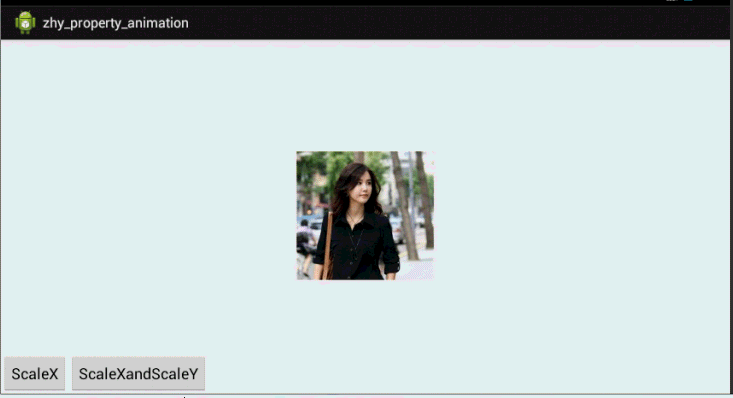
好了,通過寫xml聲明動畫,使用set嵌套set,結合orderring屬性,也基本可以實現任何動畫~~上面也演示了pivot的設置。
2、布局動畫(Layout Animations)
主要使用LayoutTransition為布局的容器設置動畫,當容器中的視圖層次發生變化時存在過渡的動畫效果。
基本代碼為:
LayoutTransition transition = new LayoutTransition();
transition.setAnimator(LayoutTransition.CHANGE_APPEARING,
transition.getAnimator(LayoutTransition.CHANGE_APPEARING));
transition.setAnimator(LayoutTransition.APPEARING,
null);
transition.setAnimator(LayoutTransition.DISAPPEARING,
null);
transition.setAnimator(LayoutTransition.CHANGE_DISAPPEARING,
null);
mGridLayout.setLayoutTransition(transition);
過渡的類型一共有四種:
(1)LayoutTransition.APPEARING 當一個View在ViewGroup中出現時,對此View設置的動畫
(2)LayoutTransition.CHANGE_APPEARING 當一個View在ViewGroup中出現時,對此View對其他View位置造成影響,對其他View設置的動畫
(3)LayoutTransition.DISAPPEARING 當一個View在ViewGroup中消失時,對此View設置的動畫
(4)LayoutTransition.CHANGE_DISAPPEARING 當一個View在ViewGroup中消失時,對此View對其他View位置造成影響,對其他View設置的動畫
(5)LayoutTransition.CHANGE 不是由於View出現或消失造成對其他View位置造成影響,然後對其他View設置的動畫。
注意動畫到底設置在誰身上,此View還是其他View。
好了下面看一個綜合的例子:
布局文件:
<LinearLayout xmlns:android="http://schemas.android.com/apk/res/android"
xmlns:tools="http://schemas.android.com/tools"
android:id="@+id/id_container"
android:layout_width="match_parent"
android:layout_height="match_parent"
android:orientation="vertical" >
<Button
android:layout_width="wrap_content"
android:layout_height="wrap_content"
android:onClick="addBtn"
android:text="addBtns" />
<CheckBox
android:id="@+id/id_appear"
android:layout_width="wrap_content"
android:layout_height="wrap_content"
android:checked="true"
android:text="APPEARING" />
<CheckBox
android:id="@+id/id_change_appear"
android:layout_width="wrap_content"
android:layout_height="wrap_content"
android:checked="true"
android:text="CHANGE_APPEARING" />
<CheckBox
android:id="@+id/id_disappear"
android:layout_width="wrap_content"
android:layout_height="wrap_content"
android:checked="true"
android:text="DISAPPEARING" />
<CheckBox
android:id="@+id/id_change_disappear"
android:layout_width="wrap_content"
android:layout_height="wrap_content"
android:checked="true"
android:text="CHANGE_DISAPPEARING " />
</LinearLayout>
代碼:
package com.example.zhy_property_animation;
import android.animation.LayoutTransition;
import android.app.Activity;
import android.os.Bundle;
import android.view.View;
import android.view.View.OnClickListener;
import android.view.ViewGroup;
import android.widget.Button;
import android.widget.CheckBox;
import android.widget.CompoundButton;
import android.widget.CompoundButton.OnCheckedChangeListener;
import android.widget.GridLayout;
public class LayoutAnimaActivity extends Activity implements
OnCheckedChangeListener
{
private ViewGroup viewGroup;
private GridLayout mGridLayout;
private int mVal;
private LayoutTransition mTransition;
private CheckBox mAppear, mChangeAppear, mDisAppear, mChangeDisAppear;
@Override
public void onCreate(Bundle savedInstanceState)
{
super.onCreate(savedInstanceState);
setContentView(R.layout.layout_animator);
viewGroup = (ViewGroup) findViewById(R.id.id_container);
mAppear = (CheckBox) findViewById(R.id.id_appear);
mChangeAppear = (CheckBox) findViewById(R.id.id_change_appear);
mDisAppear = (CheckBox) findViewById(R.id.id_disappear);
mChangeDisAppear = (CheckBox) findViewById(R.id.id_change_disappear);
mAppear.setOnCheckedChangeListener(this);
mChangeAppear.setOnCheckedChangeListener(this);
mDisAppear.setOnCheckedChangeListener(this);
mChangeDisAppear.setOnCheckedChangeListener(this);
// 創建一個GridLayout
mGridLayout = new GridLayout(this);
// 設置每列5個按鈕
mGridLayout.setColumnCount(5);
// 添加到布局中
viewGroup.addView(mGridLayout);
//默認動畫全部開啟
mTransition = new LayoutTransition();
mGridLayout.setLayoutTransition(mTransition);
}
/**
* 添加按鈕
*
* @param view
*/
public void addBtn(View view)
{
final Button button = new Button(this);
button.setText((++mVal) + "");
mGridLayout.addView(button, Math.min(1, mGridLayout.getChildCount()));
button.setOnClickListener(new OnClickListener()
{
@Override
public void onClick(View v)
{
mGridLayout.removeView(button);
}
});
}
@Override
public void onCheckedChanged(CompoundButton buttonView, boolean isChecked)
{
mTransition = new LayoutTransition();
mTransition.setAnimator(
LayoutTransition.APPEARING,
(mAppear.isChecked() ? mTransition
.getAnimator(LayoutTransition.APPEARING) : null));
mTransition
.setAnimator(
LayoutTransition.CHANGE_APPEARING,
(mChangeAppear.isChecked() ? mTransition
.getAnimator(LayoutTransition.CHANGE_APPEARING)
: null));
mTransition.setAnimator(
LayoutTransition.DISAPPEARING,
(mDisAppear.isChecked() ? mTransition
.getAnimator(LayoutTransition.DISAPPEARING) : null));
mTransition.setAnimator(
LayoutTransition.CHANGE_DISAPPEARING,
(mChangeDisAppear.isChecked() ? mTransition
.getAnimator(LayoutTransition.CHANGE_DISAPPEARING)
: null));
mGridLayout.setLayoutTransition(mTransition);
}
}
效果圖:
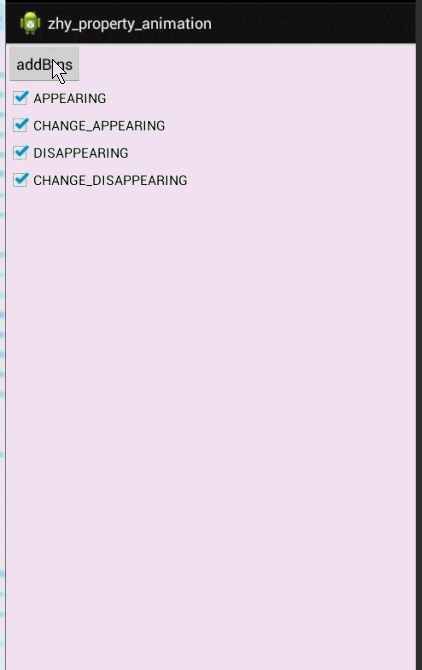
動畫有點長,耐心點看,一定要注意,是對當前View還是其他Views設置的動畫。
當然了動畫支持自定義,還支持設置時間,比如我們修改下,添加的動畫為:
mTransition.setAnimator(LayoutTransition.APPEARING, (mAppear
.isChecked() ? ObjectAnimator.ofFloat(this, "scaleX", 0, 1)
: null));
則效果為:
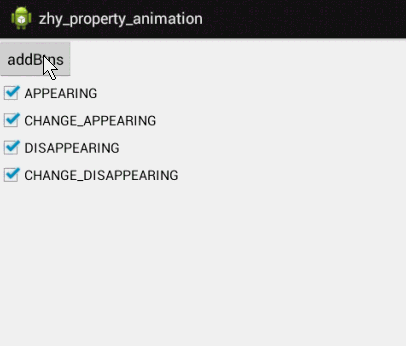
原本的淡入,變成了寬度從中間放大的效果~~是不是還不錯~~
3、View的anim方法
在SDK11的時候,給View添加了animate方法,更加方便的實現動畫效果。
布局文件:
<RelativeLayout xmlns:android="http://schemas.android.com/apk/res/android"
xmlns:tools="http://schemas.android.com/tools"
android:layout_width="match_parent"
android:layout_height="match_parent"
>
<ImageView
android:id="@+id/id_ball"
android:layout_width="wrap_content"
android:layout_height="wrap_content"
android:src="@drawable/bol_blue" />
<LinearLayout
android:layout_width="fill_parent"
android:layout_height="wrap_content"
android:layout_alignParentBottom="true"
android:orientation="horizontal" >
<Button
android:layout_width="wrap_content"
android:layout_height="wrap_content"
android:onClick="viewAnim"
android:text="View Anim" />
<Button
android:layout_width="wrap_content"
android:layout_height="wrap_content"
android:onClick="propertyValuesHolder"
android:text="PropertyValuesHolder " />
</LinearLayout>
</RelativeLayout>
代碼:
package com.example.zhy_property_animation;
import android.animation.ObjectAnimator;
import android.animation.PropertyValuesHolder;
import android.app.Activity;
import android.os.Bundle;
import android.util.DisplayMetrics;
import android.util.Log;
import android.view.View;
import android.widget.ImageView;
public class ViewAnimateActivity extends Activity
{
protected static final String TAG = "ViewAnimateActivity";
private ImageView mBlueBall;
private float mScreenHeight;
@Override
protected void onCreate(Bundle savedInstanceState)
{
super.onCreate(savedInstanceState);
setContentView(R.layout.view_animator);
DisplayMetrics outMetrics = new DisplayMetrics();
getWindowManager().getDefaultDisplay().getMetrics(outMetrics);
mScreenHeight = outMetrics.heightPixels;
mBlueBall = (ImageView) findViewById(R.id.id_ball);
}
public void viewAnim(View view)
{
// need API12
mBlueBall.animate()//
.alpha(0)//
.y(mScreenHeight / 2).setDuration(1000)
// need API 12
.withStartAction(new Runnable()
{
@Override
public void run()
{
Log.e(TAG, "START");
}
// need API 16
}).withEndAction(new Runnable()
{
@Override
public void run()
{
Log.e(TAG, "END");
runOnUiThread(new Runnable()
{
@Override
public void run()
{
mBlueBall.setY(0);
mBlueBall.setAlpha(1.0f);
}
});
}
}).start();
}
}
簡單的使用mBlueBall.animate().alpha(0).y(mScreenHeight / 2).setDuration(1000).start()就能實現動畫~~不過需要SDK11,此後在SDK12,SDK16又分別添加了withStartAction和withEndAction用於在動畫前,和動畫後執行一些操作。當然也可以.setListener(listener)等操作。
使用ObjectAnimator實現上面的變化,我們可以使用:PropertyValueHolder
PropertyValuesHolder pvhX = PropertyValuesHolder.ofFloat("alpha", 1f,
0f, 1f);
PropertyValuesHolder pvhY = PropertyValuesHolder.ofFloat("y", 0,
mScreenHeight / 2, 0);
ObjectAnimator.ofPropertyValuesHolder(mBlueBall, pvhX, pvhY).setDuration(1000).start();
效果與上面一樣。
運行結果:
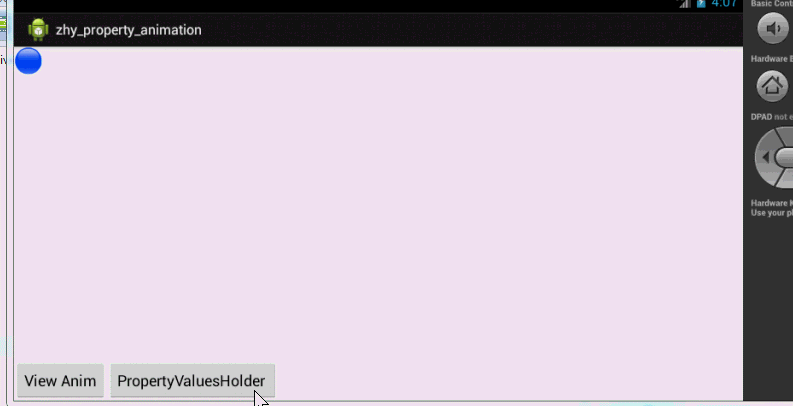
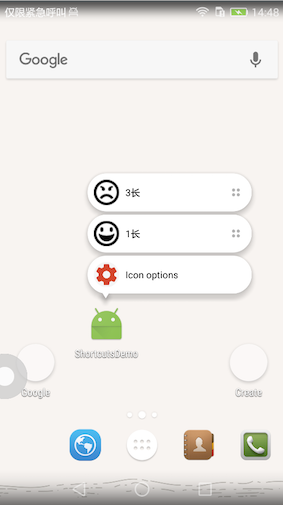 Android 7.1 快捷方式 Shortcuts
Android 7.1 快捷方式 Shortcuts
前些天就看到相關內容了,但是最近吸毒比較深(wow),所以沒有緊跟潮流,今天補一篇。https://github.com/ddwhan0123/Useful-Open-S
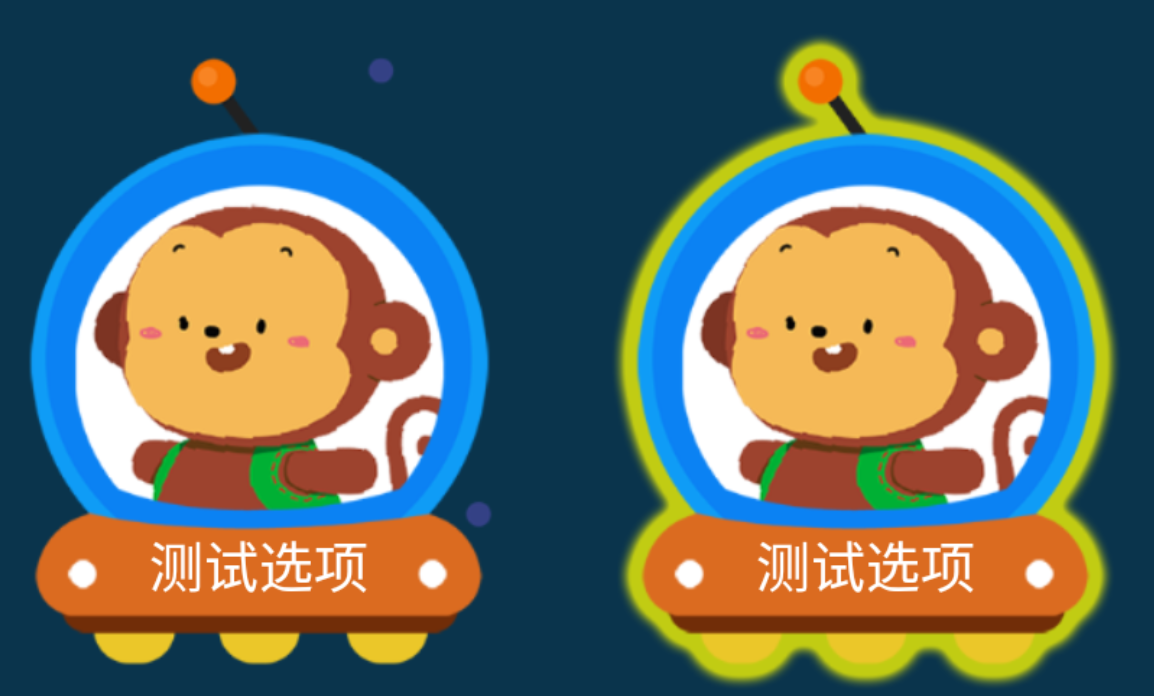 自定義GridView的使用(盒子應用)
自定義GridView的使用(盒子應用)
突然發現好久沒有寫博客了,一直放到筆記裡面,今天update一下。最近做的一個項目中,是盒子+電視,用戶通過遙控器來操作。這裡只是說下GridView在當前業務下的簡單使
 Intent Filter匹配規則
Intent Filter匹配規則
Intent簡介Android中提供了Intent機制來協助應用間的交互與通訊,Intent負責對應用中一次操作的動作、動作涉及數據、附加數據進行描述,Android則根
 微信理財通收益計算 微信理財通收益如何
微信理財通收益計算 微信理財通收益如何
你現在還是把錢都存在余額寶?相信你也注意到,現在理財方式越來越多,余額寶的收益也越來越低,如今微信也有理財通,也很多朋友加入購買。對微信理財通手機以了解?下